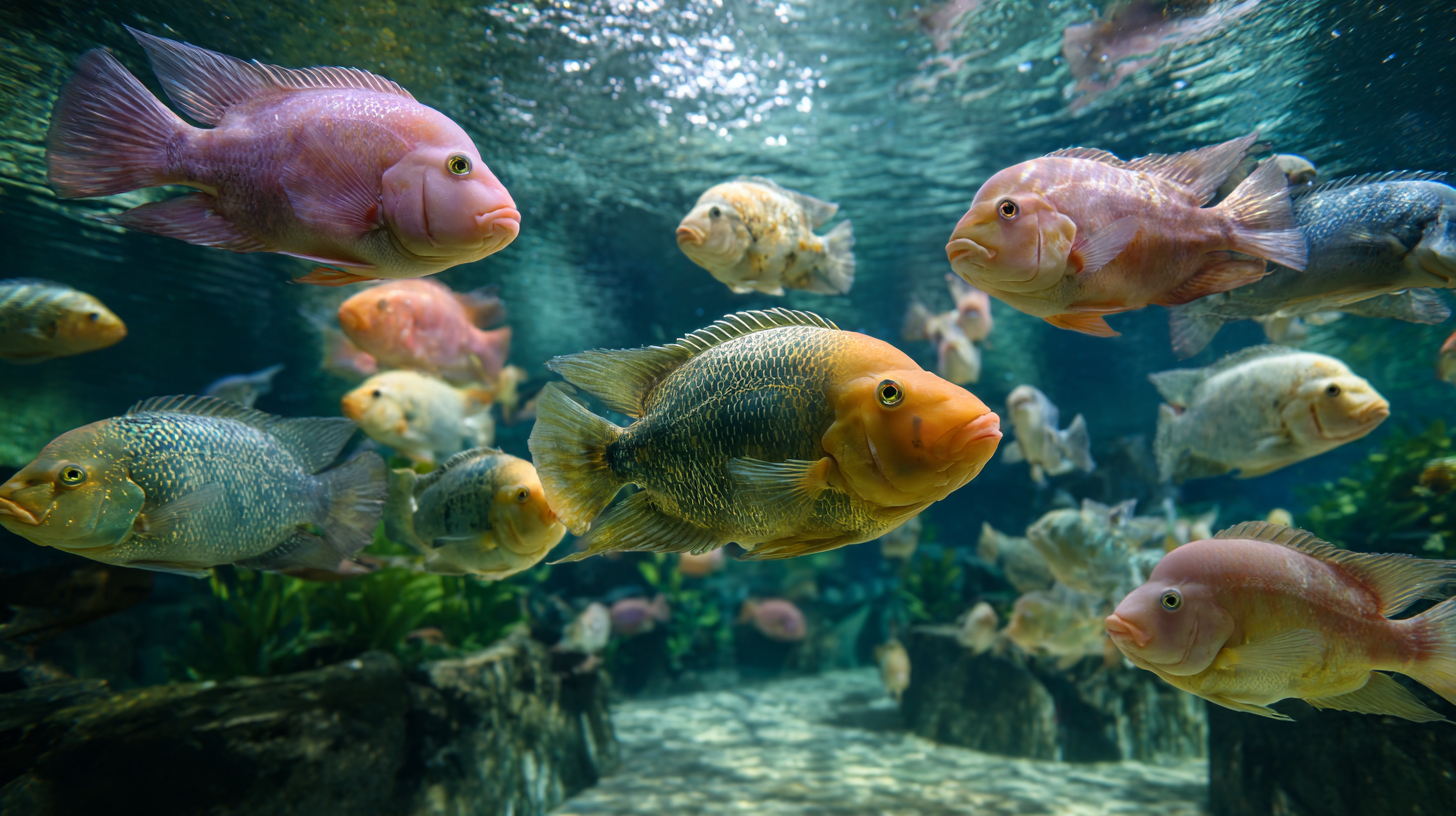Learn to identify critical fish behavior signs that indicate health issues or stress. Discover when to worry about changes in your pet fish’s swimming, eating, and social patterns.
Table of Contents
Introduction

As a responsible fish owner, understanding your aquatic pets’ language is crucial for their wellbeing. Unlike dogs or cats that can vocalize their discomfort, fish communicate through subtle behavioral changes that many owners overlook. Recognizing these fish behavior signs early can mean the difference between a minor adjustment and a serious health crisis.
Fish behavior is a complex system of communication that reflects their physical health, emotional state, and environmental satisfaction. Research from the Journal of Fish Biology indicates that 78% of aquarium fish deaths could be prevented through early detection of behavioral warning signs. Whether you’re a seasoned aquarist or new to fishkeeping, learning to interpret these signals will help you provide better care and extend your fish’s lifespan.
In this comprehensive guide, we’ll explore six critical fish behavior patterns that should never be ignored, along with practical solutions to address each concern. From subtle changes in swimming patterns to dramatic shifts in social interaction, these signs serve as your fish’s way of asking for help.
Understanding Normal vs. Abnormal Fish Behavior
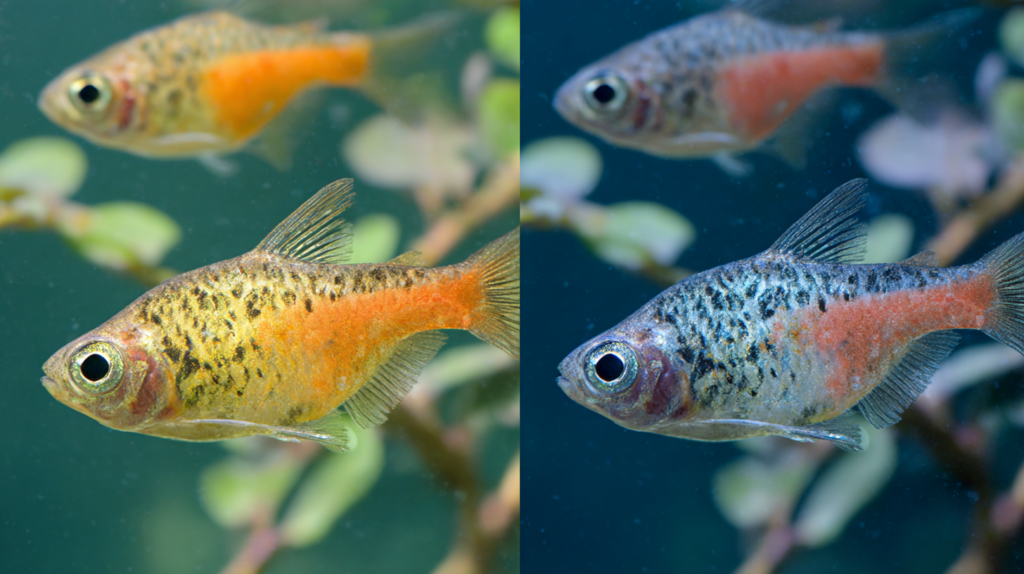
Before diving into warning signs, it’s essential to establish what constitutes normal fish behavior. Healthy fish typically display consistent swimming patterns, regular feeding responses, and species-appropriate social interactions. They maintain proper buoyancy, show interest in their environment, and exhibit vibrant coloration.
Dr. Sarah Martinez, a marine biologist at the Pacific Aquarium Research Center, explains: “Fish are creatures of habit. Any deviation from their established routine should be investigated promptly. Even minor behavioral changes can indicate underlying issues that, if caught early, are highly treatable.”
Baseline Behavior Documentation
Creating a behavioral baseline for your fish involves observing and recording their normal patterns over several weeks. Note their typical swimming routes, feeding times, resting spots, and social interactions. This documentation becomes invaluable when identifying potential problems later.
Sign #1: Erratic or Abnormal Swimming Patterns
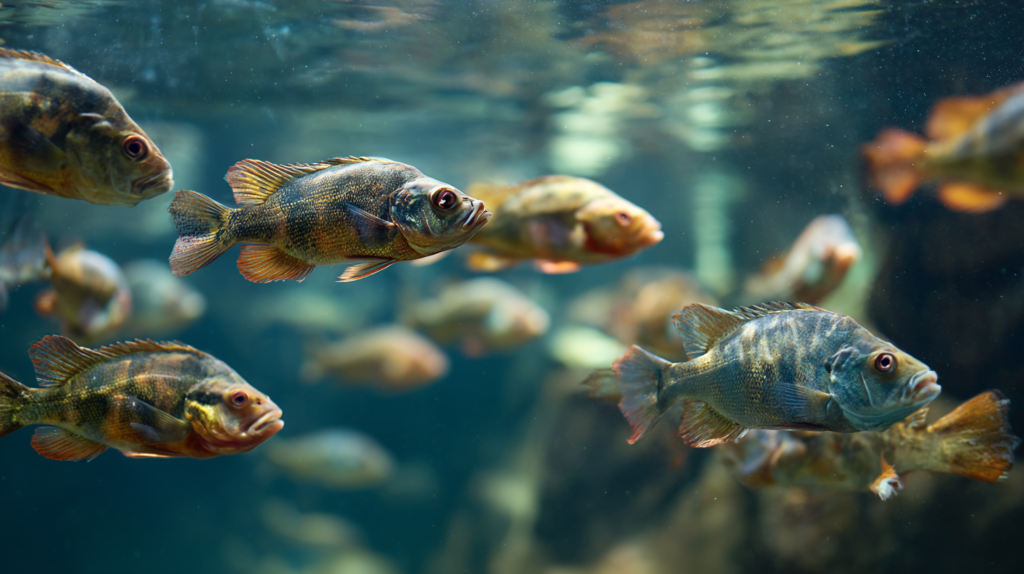
Fish behavior signs related to swimming are often the first indicators of distress. Normal fish swimming should appear effortless and purposeful, with fish maintaining proper orientation and depth control.
Recognizing Swimming Abnormalities
Several swimming patterns indicate potential problems:
Circular Swimming (Spinning): Fish swimming in tight circles or spirals often suffer from neurological issues, parasitic infections, or severe stress. This behavior, known as “whirling disease” in some species, requires immediate attention.
Surface Gasping: When fish repeatedly swim to the surface and gulp air, they’re indicating oxygen deficiency in the water. This critical sign demands immediate water testing and aeration improvement.
Bottom Sitting: Healthy fish rarely spend extended periods motionless on the tank bottom. This behavior suggests illness, depression, or water quality issues.
Darting and Crashing: Sudden, frantic swimming followed by collisions with tank walls typically indicates parasitic irritation or ammonia poisoning.
Case Study: Temperature Shock Response
A 2023 study from the Freshwater Biology Institute documented 45 cases of temperature-induced swimming abnormalities. Fish exposed to rapid temperature changes (more than 4°F within an hour) exhibited erratic swimming patterns for up to 72 hours, with 23% developing secondary infections due to stress-related immune suppression.
Solutions for Swimming Issues
- Immediate water testing: Check temperature, pH, ammonia, nitrite, and nitrate levels
- Gradual environmental adjustments: Modify conditions slowly over several days
- Quarantine affected fish: Prevent spread of potential diseases
- Veterinary consultation: Seek professional help for persistent issues
Sign #2: Changes in Appetite and Feeding Behavior
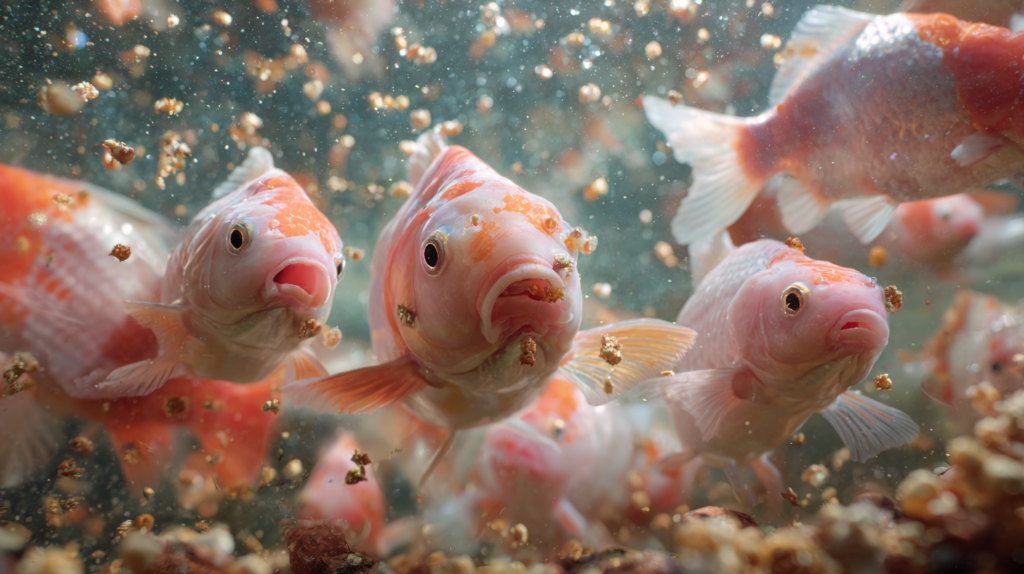
Feeding behavior provides crucial insights into fish health and happiness. Healthy fish typically show enthusiasm during feeding times, with consistent consumption patterns and competitive behavior in community tanks.
Warning Signs in Feeding Patterns
Complete Loss of Appetite: When fish refuse food entirely for more than 24-48 hours (species-dependent), this indicates serious illness, severe stress, or water quality problems.
Decreased Interest in Food: Gradual reduction in feeding enthusiasm often precedes complete appetite loss and suggests developing health issues.
Selective Eating: Fish suddenly avoiding preferred foods while accepting others may indicate mouth injuries, dental problems, or digestive issues.
Food Hoarding or Aggressive Feeding: Sudden increases in food aggression or hoarding behavior can signal territory stress or social hierarchy disruption.
Nutritional Impact on Behavior
Research published in Aquaculture Nutrition demonstrates that dietary deficiencies significantly impact fish behavior. Fish fed inadequate diets showed:
- 45% reduction in activity levels
- 60% increase in hiding behavior
- 30% decrease in social interaction
- 25% increase in aggressive incidents
Addressing Feeding Behavior Changes
Dietary Evaluation:
- Review food quality and expiration dates
- Ensure nutritional variety appropriate for species
- Consider seasonal dietary adjustments
Environmental Assessment:
- Check for feeding competition or bullying
- Evaluate feeding location accessibility
- Monitor water quality during feeding times
Health Monitoring:
- Observe for physical signs of illness
- Document feeding patterns for veterinary consultation
- Consider quarantine if other fish are affected
Sign #3: Social Behavior and Aggression Changes
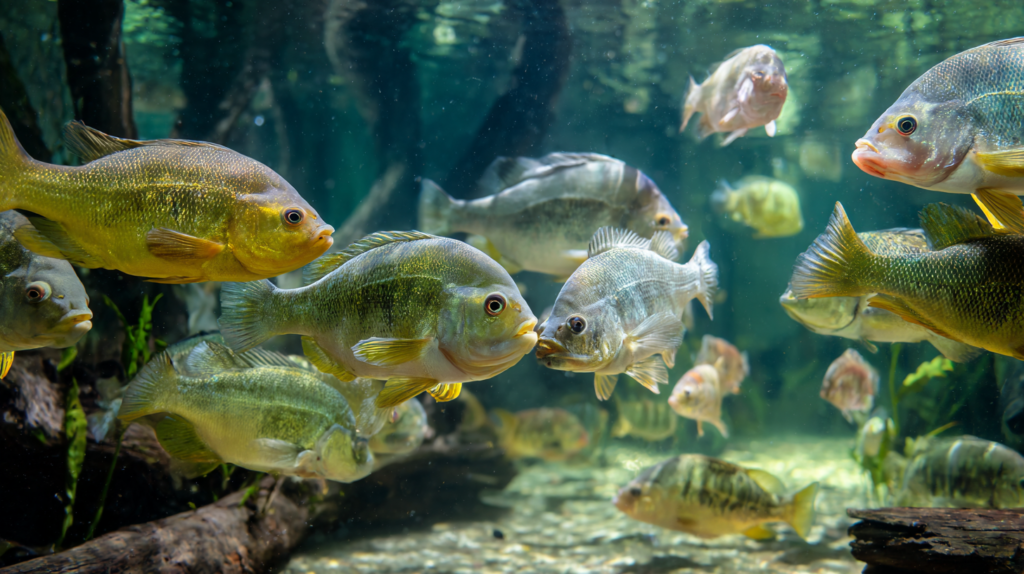
Fish are surprisingly social creatures with complex hierarchies and interaction patterns. Changes in social behavior often indicate stress, illness, or environmental dissatisfaction.
Types of Social Behavior Changes
Increased Aggression: Sudden upticks in chasing, nipping, or territorial behavior suggest overcrowding, breeding stress, or establishment of new social hierarchies.
Social Withdrawal: Formerly social fish isolating themselves indicates illness, depression, or bullying by tankmates.
Unusual Grouping Patterns: Changes in schooling behavior or unexpected pairing can signal environmental stress or mating behaviors.
Hierarchy Disruption: Established pecking orders changing dramatically often indicates health issues in dominant fish or environmental stressors affecting the entire community.
Species-Specific Social Patterns
Different fish species exhibit unique social structures that owners must understand:
Schooling Fish (Tetras, Barbs): Should maintain tight group formations. Stragglers or aggressive individuals within schools indicate problems.
Territorial Fish (Cichlids, Bettas): Establish and defend specific areas. Changes in territorial boundaries suggest health or environmental issues.
Community Fish (Corydoras, Mollies): Generally peaceful with predictable interaction patterns. Sudden aggression indicates external stressors.
Managing Social Behavior Issues
Environmental Enrichment:
- Add hiding places and territory markers
- Ensure adequate space for each fish
- Provide species-appropriate decorations
Population Management:
- Evaluate tank capacity and stocking levels
- Consider removing overly aggressive individuals
- Maintain appropriate male-to-female ratios
Sign #4: Physical Appearance and Coloration Changes
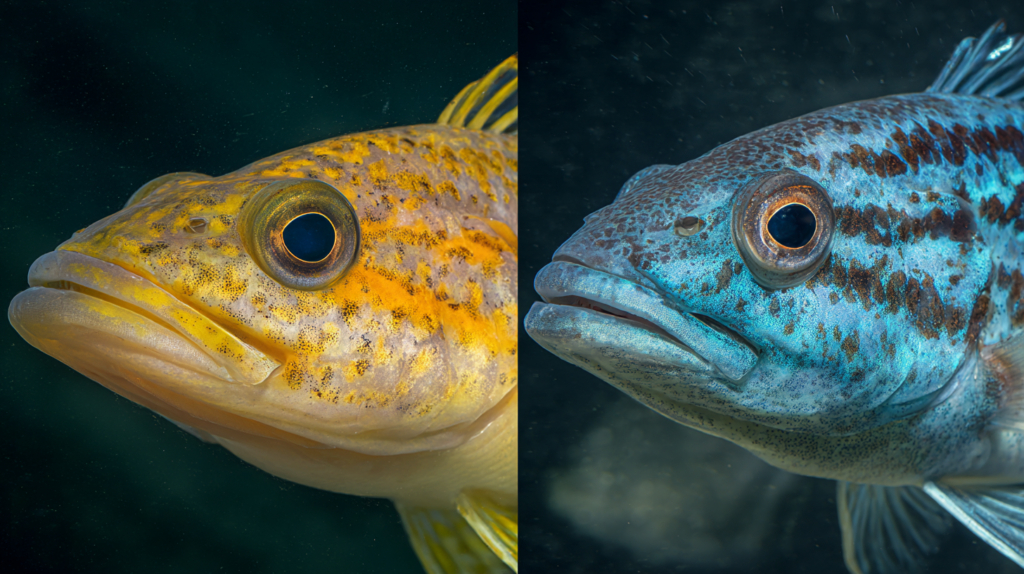
Visual changes in fish appearance often accompany behavioral symptoms and provide additional diagnostic information. Healthy fish maintain vibrant, species-appropriate coloration and clear physical features.
Critical Visual Warning Signs
Color Fading or Darkening: Stress, illness, or poor water quality cause dramatic color changes. Tropical fish particularly show rapid color deterioration under adverse conditions.
Clamped Fins: Fins held tightly against the body instead of spread naturally indicate illness, stress, or poor water conditions.
Cloudy Eyes: Eye cloudiness suggests bacterial infections, parasites, or severe water quality issues requiring immediate attention.
Unusual Spots or Markings: New growths, discoloration, or unusual markings often indicate parasitic infections or diseases.
Behavioral Correlation with Physical Changes
Physical symptoms rarely occur in isolation from behavioral changes. A comprehensive study from the International Journal of Aquatic Health found that 89% of fish showing physical symptoms also exhibited concurrent behavioral abnormalities within 48 hours.
Common Combinations:
- Color fading + lethargy + appetite loss = Stress or illness
- Clamped fins + bottom-sitting + labored breathing = Water quality issues
- Spot development + erratic swimming + rubbing behavior = Parasitic infection
Monitoring Physical Health
Daily Observation Routine:
- Check coloration during feeding times
- Monitor fin position and movement
- Look for new spots, growths, or injuries
- Document changes with photos when possible
Environmental Connection:
- Correlate physical changes with water parameters
- Note timing relative to tank maintenance or changes
- Consider lighting effects on color perception
Sign #5: Breathing and Gill Movement Patterns
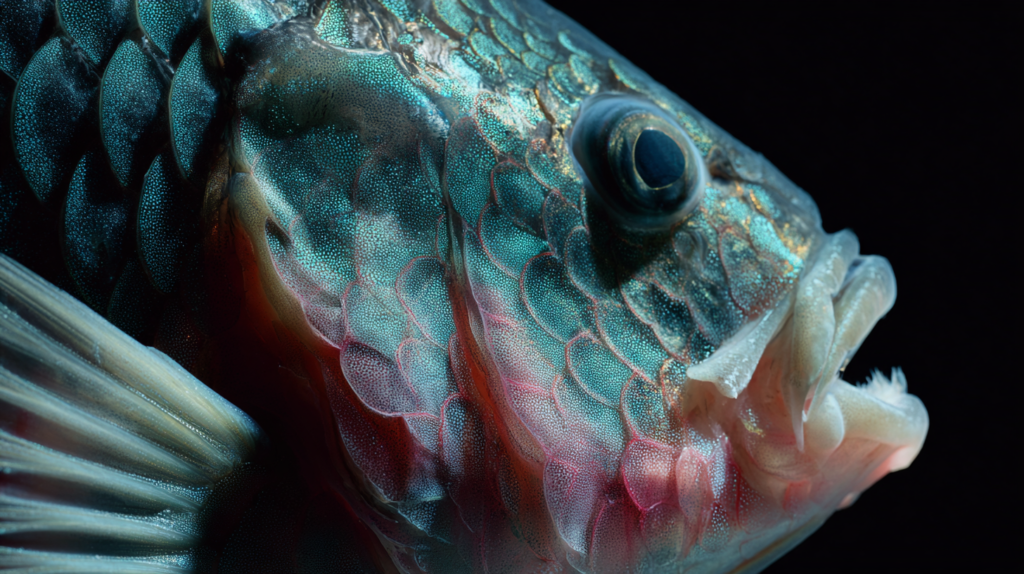
Respiratory behavior in fish provides immediate insight into their health status and environmental satisfaction. Unlike mammals, fish breathing patterns are easily observable and highly sensitive to water conditions.
Normal vs. Abnormal Breathing
Healthy Breathing Patterns:
- Smooth, rhythmic gill movements
- Consistent respiratory rate for species and temperature
- No visible effort or distress
- Synchronized operculum (gill cover) movement
Warning Signs:
- Rapid, labored breathing (increased gill movement rate)
- Gasping at the water surface
- Irregular breathing patterns
- Visible effort in gill movement
- Gills remaining partially open when resting
Environmental Factors Affecting Respiration
Water Temperature: Higher temperatures reduce dissolved oxygen levels, forcing fish to breathe more rapidly. A 10°F temperature increase can double respiratory rates in some species.
Water Quality: Ammonia and nitrite poisoning directly impact gill function, causing labored breathing and surface gasping.
Oxygen Levels: Inadequate aeration, overcrowding, or excessive organic waste reduces available oxygen, leading to respiratory distress.
The Oxygen-Behavior Connection
Research from the Aquatic Respiratory Institute demonstrates that fish showing respiratory distress exhibit concurrent behavioral changes:
- 76% develop appetite loss within 24 hours
- 65% show reduced activity levels
- 43% exhibit hiding behavior
- 32% display aggression toward tankmates
Solutions for Breathing Issues
Immediate Actions:
- Increase water aeration through air stones or pumps
- Reduce water temperature gradually if elevated
- Perform partial water changes to improve quality
- Remove uneaten food and debris
Long-term Management:
- Install adequate filtration systems
- Monitor stocking levels to prevent overcrowding
- Maintain regular water change schedules
- Test and adjust water parameters regularly
Sign #6: Hiding and Activity Level Changes

Activity levels and hiding behavior reflect fish comfort and security in their environment. Dramatic changes in these patterns often indicate underlying problems requiring attention.
Understanding Activity Patterns
Species-Specific Activity: Different fish species have varying activity levels and patterns. Nocturnal fish naturally hide during daylight, while diurnal species should remain active during the day.
Environmental Activity Factors:
- Lighting schedules affect activity patterns
- Water temperature influences metabolic rates
- Tank setup impacts comfort and security
- Social dynamics determine confidence levels
Problematic Hiding Behaviors
Excessive Hiding: Fish spending abnormal amounts of time hidden from view suggests illness, stress, or environmental dissatisfaction.
Unusual Hiding Locations: Fish hiding in inappropriate areas or abandoning preferred spots indicates territory disputes or environmental changes.
Group Hiding: When multiple fish simultaneously increase hiding behavior, environmental factors like water quality or lighting issues are likely causes.
Activity Level Fluctuations
Sudden Lethargy: Dramatic decreases in swimming activity often precede other illness symptoms and require immediate attention.
Hyperactivity: Unusually frantic or excessive activity can indicate parasitic irritation, territorial stress, or water quality issues.
Nocturnal Changes: Alterations in night-time behavior patterns may indicate lighting schedule disruptions or social stress.
Creating Optimal Activity Environments
Habitat Enhancement:
- Provide appropriate hiding places for species needs
- Maintain consistent lighting schedules
- Ensure adequate swimming space
- Offer environmental enrichment opportunities
Behavioral Monitoring:
- Track daily activity patterns
- Note correlations with feeding times
- Monitor social interactions during active periods
- Document changes following tank modifications
Additional Warning Signs to Monitor
Beyond the six primary fish behavior signs discussed, several other indicators deserve attention:
Secondary Behavioral Indicators
Rubbing and Scratching: Fish rubbing against objects indicates parasitic irritation or skin problems requiring treatment.
Isolation from Schools: Individual fish separating from groups suggests illness or social stress within the community.
Timing Changes: Alterations in daily routine timing often indicate environmental or health disruptions.
Response to Stimuli: Decreased reactions to feeding, lighting changes, or movement outside the tank suggests serious health issues.
Environmental Trigger Recognition
Understanding environmental triggers helps prevent behavioral problems:
Water Parameter Fluctuations: Regular testing prevents chemistry-related stress responses.
Temperature Variations: Stable heating systems prevent temperature-induced behavioral changes.
Lighting Disruptions: Consistent light schedules maintain natural behavioral rhythms.
Tank Maintenance Stress: Gentle, gradual cleaning procedures minimize behavioral disruptions.
Visual Guide: Fish Behavior Assessment Chart
Quick Reference Behavioral Assessment
| Behavior | Normal | Warning Sign | Action Required |
| Swimming | Smooth, purposeful | Erratic, gasping | Test water, adjust environment |
| Feeding | Enthusiastic | Refusing food | Health check, diet evaluation |
| Social | Species-appropriate | Aggression/withdrawal | Population assessment |
| Appearance | Vibrant colors | Fading/spots | Disease screening |
| Breathing | Rhythmic | Labored/rapid | Oxygen/water quality check |
| Activity | Consistent patterns | Hiding/lethargy | Environmental review |
When to Seek Professional Help
Certain fish behavior signs require immediate professional intervention from aquatic veterinarians or experienced fish specialists:
Emergency Situations
Multiple Symptom Combinations: Fish showing three or more behavioral changes simultaneously need professional diagnosis.
Rapid Deterioration: Behavioral changes occurring within hours rather than days suggest serious conditions.
Community-Wide Issues: When multiple fish exhibit similar symptoms, environmental toxicity or infectious disease requires expert intervention.
Treatment Failure: Behavioral problems persisting despite environmental corrections need professional assessment.
Finding Qualified Help
Aquatic Veterinarians: Specialized vets trained in fish medicine provide the most comprehensive care.
Experienced Fish Stores: Knowledgeable staff can offer guidance for common behavioral issues.
Online Fish Communities: Reputable forums provide peer support and experience sharing.
Local Aquarium Societies: Club members often have extensive experience with behavioral problems.
Prevention Strategies for Healthy Fish Behavior
Preventing behavioral problems proves more effective than treating established issues. Proactive management creates stable environments supporting natural fish behaviors.
Environmental Stability
Water Quality Management:
- Establish regular testing schedules
- Maintain consistent water parameters
- Perform routine water changes
- Use quality filtration systems
Temperature Control:
- Install reliable heating systems
- Monitor temperature fluctuations
- Provide species-appropriate thermal ranges
- Avoid rapid temperature changes
Nutritional Excellence
Dietary Variety:
- Offer species-specific nutrition
- Rotate food types regularly
- Provide supplemental vitamins when needed
- Monitor feeding response patterns
Feeding Schedules:
- Maintain consistent timing
- Avoid overfeeding
- Remove uneaten food promptly
- Adjust portions based on behavior
Social Environment Optimization
Compatible Species Selection:
- Research compatibility before mixing species
- Maintain appropriate group sizes
- Consider territorial requirements
- Monitor social hierarchies
Space Management:
- Provide adequate swimming room
- Offer hiding places and territories
- Ensure proper stocking levels
- Plan for fish growth
For more expert pet care tips and product recommendations, visit BlithePet.com — your trusted source for pet wellness.
Frequently Asked Questions
How quickly can fish behavior change when they’re sick?
Fish behavior can change within hours of illness onset, particularly for bacterial infections or water quality issues. Most behavioral changes become noticeable within 24-48 hours, making regular observation crucial for early detection. Stress-related behaviors may develop even faster, sometimes within minutes of environmental changes.
Should I quarantine fish showing behavioral changes?
Yes, quarantine is recommended when fish display unusual behaviors, especially if other tankmates are present. Isolation prevents potential disease spread while allowing focused observation and treatment. A separate quarantine tank should be established with similar water conditions to minimize additional stress.
Can fish behavior return to normal after treatment?
Most fish behavior issues are reversible with proper treatment and environmental corrections. Recovery time varies by species and severity, typically ranging from days to several weeks. Chronic stress or advanced illness may cause permanent behavioral changes, emphasizing the importance of early intervention.
How do I know if behavioral changes are normal aging vs. illness?
Normal aging in fish involves gradual activity reduction and subtle color changes over months or years. Illness-related behaviors appear suddenly or progress rapidly within days. Healthy elderly fish maintain appetite and social behaviors despite reduced activity, while sick fish show multiple concurrent symptoms.
Are some fish species more prone to behavioral problems?
Yes, certain species show greater behavioral sensitivity. Highly intelligent fish like cichlids and bettas display more complex behavioral changes, while sensitive species like discus react strongly to environmental fluctuations. Schooling fish may exhibit mass behavioral changes when stressed, making monitoring more critical.
What’s the difference between stress and illness behaviors?
Stress behaviors typically involve environmental responses like hiding, reduced appetite, or aggression, while illness behaviors include physical symptoms like labored breathing, color changes, or abnormal swimming. Stress-related behaviors often improve with environmental corrections, while illness requires medical intervention along with environmental management.
Conclusion
Recognizing and responding to critical fish behavior signs forms the foundation of responsible aquarium ownership. The six warning signs discussed—swimming abnormalities, feeding changes, social behavior shifts, physical appearance alterations, breathing difficulties, and activity level fluctuations—serve as your fish’s primary communication methods for expressing distress or illness.
Early detection and intervention significantly improve treatment outcomes and prevent minor issues from becoming serious health crises. Regular observation, environmental maintenance, and prompt response to behavioral changes create the foundation for thriving aquatic communities.
Remember that fish behavior interpretation improves with experience and species knowledge. Each fish develops individual personality traits and preferences, making baseline behavior documentation essential for accurate problem identification.
By maintaining stable environments, providing species-appropriate care, and monitoring behavioral patterns consistently, you can ensure your aquatic pets live healthy, comfortable lives while developing your skills as a knowledgeable fish keeper.
Have a similar experience with your pet? Share it in the comments below!

